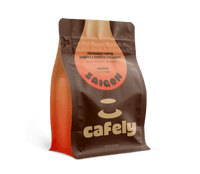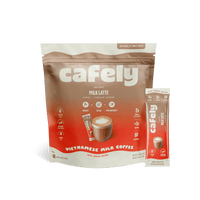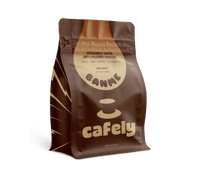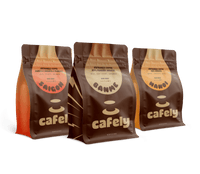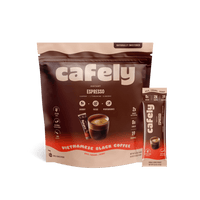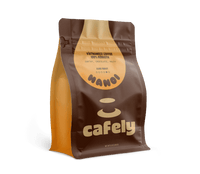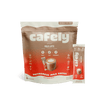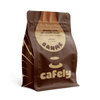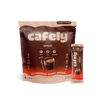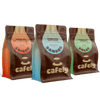Coffee beans can be ground using several methods such as a grinder, blender, or food processor — but the grinder is the only way to ensure a fine and consistent enough grind.
The coarseness of the grind heavily impacts the cup of coffee, but what grind to use depends on the brewing method, as each one requires something different.
Types of Coffee Grinders
Coffee is recognized for its delicious taste, a multitude of potential benefits, and stimulating effects proven to be powerful enough to improve driving [1]. But how do you grind coffee beans and ensure you get the best taste and aroma it has to offer — and not end up with a weak or bitter cup of coffee?
1. Blade Coffee Grinder
Using a coffee grinder is the most straightforward, easy way of grinding your coffee beans. There are two main types of coffee grinders: a blade grinder and a burr grinder. The first uses blades to chop the coffee beans into smaller pieces, but this doesn’t always lead to evenly processed grounds.
Blade grinders can cut through beans with ease while producing a relatively consistent result. Blade grinders are a quick, efficient option for coffee grinding and are easy to clean. The noise they make while processing beans can be off-putting, but it shouldn’t take long for the coffee to be ready for brewing.
Pros & Cons:
- ✅ Cheap & Widely Available.
- ✅ Can be used for all levels of grind (fine–coarse).
- ❌ Particle size is inconsistent
2. Flat Burr Coffee Grinder
Compared to a blade grinder, a flat burr grinder is a more favorable option leading to evenly ground coffee. The burrs can be adjusted to produce the desired coffee grind from coarse to fine. Nowadays, it’s more common to use an automatic burr grinder, though it’s possible to purchase a manual one, where you turn the handle to grind the beans.
A fine grind with a flat burr coffee grinder is ideal for our BanMe Coffee, and a phin filter, where the intensity of the dark roast can be tasted in full with every sip. The fruity notes of dark cherry invigorate your taste buds, where the fine grind allows the explosive flavors to infuse with water, making a punchy cup of coffee.
Pros & Cons:
- ✅ Produces uniformly ground coffee, enhancing flavor extraction.
- ✅ Adjustable settings allow for precise control over grind size.
- ❌ Generally more expensive than blade grinders.
- ❌ Requires more maintenance and cleaning.
- ❌ Can be noisier and larger than other grinders.
3. Conical Burr Grinder
Conical burr grinders differ from flat burr grinders in that they use sharp cone-shaped burrs to process coffee beans. They’re known for creating a smooth and relatively consistent grind, plus it’s quieter and less expensive than conical burr grinders. As conical burrs work cooler than blade grinders, the flavor and natural aromas of the coffee remain.
Pros & Cons:
- ✅ Less heat generated during grinding, preserving coffee flavors.
- ✅ Quieter operation compared to flat burr and blade grinders.
- ❌ More expensive than blade grinders.
- ❌ May retain more coffee grounds, requiring regular cleaning.
- ❌ Slightly less consistent than flat burr grinders.
4. Blender or Food Processor
Learning how to grind coffee beans with a blender means you aren’t stuck the next time you’re gifted (or accidentally buy) whole coffee beans or you’re somewhere without a grinder.
Modern blenders may even have a ‘grinding’ option automatically built into the machine, but if not, you can pour the desired amount of beans into the blender and pulse them for short bursts.
Be aware you may not achieve a consistent result using a blender. Only blend for short bursts, as blenders can produce heat when in use, and you don't want to heat up or burn the coffee.
A food processor works similarly to a blender and is another option. Food processors tend to be bigger than blenders, so you may need to increase the quantity of beans so they grind well. Just like when using a blender, avoid processing for large stints of time, as this can generate heat and burn the coffee.
It can also be difficult to clean coffee residue from a blender and a food processor, but these are two potential methods if using a grinder isn’t possible.
Pros & Cons:
- ✅ Convenient if you already own one and don’t want to buy a dedicated coffee grinder.
- ✅ Useful for grinding large quantities of beans at once.
- ❌ Very inconsistent grind, which can adversely affect the coffee's taste.
- ❌ Generates heat, which may alter coffee flavor and aroma.
- ❌ Difficult to clean coffee residues from the device.
What are the Different Grinds of Coffee?

The different grinds of coffee are coarse, medium-coarse, medium, medium-fine, fine, and extra-fine. Each grind suits various types of coffee, with coarser grinds optimal for immersion methods or pour-over brewers, while finer grinds are perfect for espresso machines.
The following chart goes over when to use each grind and what each looks like.
|
Grind Type |
Best Use |
|
Coarse (Coarse sea salt) |
Best suited for cold brew coffee, regular French press, percolators, and other methods requiring a longer extraction time. |
|
Medium-coarse (Rough sand) |
Ideal for pour-over coffee, Chemex brewer, and other similar methods. |
|
Medium (Sand) |
Well-suited siphon, Aeropress coffeemaker, or drip coffee. Popular option as it works well for many methods. |
|
Medium-fine (Smooth sand) |
Medium-fine beans can be used similarly to medium beans. As the coffee grounds are smaller, reduce the brewing time to avoid an intense and potentially bitter brew. |
|
Fine (Table salt) |
Perfect for espresso machines, phin filters, moka pots, and methods requiring a quick extraction. |
|
Extra-fine (Powdered sugar) |
Commonly used for Turkish coffee (ibrik) and sometimes espresso. |
With numerous coffee grinds available, it can be hard to know which one to use in your coffee. Let’s talk about the grinds used for the most popular brewing methods.
What Coffee Grinds Do the Most Popular Brewing Methods Require?
The most popular coffee brewing methods in the US are pods and drip coffee [2]. For drip coffee, most machines require medium or medium-fine ground beans.
Medium grind produces balanced coffee deep in flavor and strength without any bitter undertones.
This size allows for even extraction, where water flow is slowed, and flavors can infuse the water. Using coarse grounds with drip coffee will lead to under-extraction and a watery coffee lacking flavor. Fine or extra-fine grounds increase the surface area, so water has more contact with coffee, leading to a strong but bitter brew.
Related: Guide to Different Types of Brewing Methods
How Does Grind Type Impact Coffee?
By grinding whole beans into smaller pieces, the surface area is increased. This allows coffee to have better contact with water during brewing, letting all of the key flavors and aromas infuse the water. Different grinds impact coffee depending on how slowly or quickly the water flows through the coffee grounds.
The goal of breaking down coffee beans is to improve extraction and create a flavorful but balanced cupful. As various brewing methods exist, it’s essential to use the correct coffee grind to achieve even extraction. If you’re repeatedly experiencing a disappointing cup of coffee in the morning, it may not be the fault of your beans!
Experiment with different grounds suitable for your brewing method and see if you can improve flavor. A grind too coarse for your chosen method may not provide enough time for the deep flavors and aromas to escape from the coffee, leading to a weak and watery result. Using a grind too fine has the opposite effect, as it can lead to over-extraction, where an unpleasant bitter flavor is the dominant outcome.
Related: Vietnamese Coffee Grind Size
How Long to Grind Coffee Beans?
The length of time to grind coffee beans depends on the desired consistency and type of coffee you’re making. A coarse grind requires around 10 seconds using an electric grinder. Medium grind coffee needs a little longer to process the grounds more finely, so 15 seconds should be adequate time. A fine grind used for an espresso machine needs substantially longer to process the beans, so it’s best to grind them for a minimum of 30 seconds.
However, this is just an estimation, as each grinder is different. The grind time will vary greatly, so it's best to experiment.
FAQs: Grinding Coffee

Just in case you still have questions, we’ll go over a few of the most common ones next.
1. Do you have to grind coffee beans?
Grinding coffee beans is a must to achieve a balanced, flavorful cup. When introduced to hot water, the coffee needs to be fine enough so the flavors and oils can infuse into the water. Using whole beans will result in a cup of watery coffee lacking intensity and taste.
2. Is it better to grind coffee fine or coarse?
There is no set grind that’s ideal for every method. Most pre-ground coffee is medium grind, but this won’t give you the best flavor for many brewing methods.
The coarseness of your coffee depends on the consistency you need to make your brew. French press coffee requires coarsely ground beans, while espresso needs finely ground coffee to deliver an intense cupful.
3. Can I blend different coffee beans?
Uniting different coffee beans and grinding them together leads to a unique cup of coffee, adding depth of flavor and exciting combinations. Any grinding method can be used, and you can pair beans together based on their key flavor notes and origins.
In fact, you can buy beans pre-mixed if you don’t want to try it yourself. Our SaiGon OG consists of robusta, arabica, and peaberry for the ultimate blend of strength and balanced flavor.
If you want to try your hand at blending coffee, start with the freshest beans, such as our arabica (DaLat), robusta (HaNoi), and peaberry robusta (BanMe).
4. Does coffee taste better if you grind your own beans?
Buying whole beans and grinding them as you need them increases the freshness of your coffee. Opting for pre-ground coffee beans means some of the flavors have already started to weaken. Grinding your beans at home means you are guaranteed a fresh cup of coffee bursting with intense flavor and aroma. Just make sure to clean your coffee grinder before using to avoid any leftover residue affecting flavor and quality.
References
- J. Mets, M. A., Baas, D., Olivier, B., & Verster, J. C. (2012). Effects of coffee on driving performance during prolonged simulated highway driving. Psychopharmacology, 222(2), 337-342.
- M. Ridder (2024). Preferred methods of brewing/making coffee in the US 2023. Statista.
